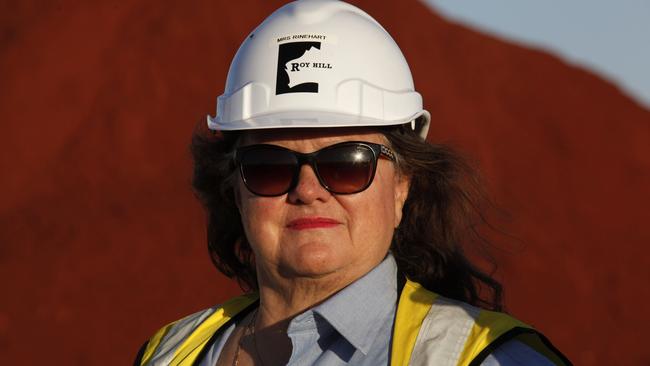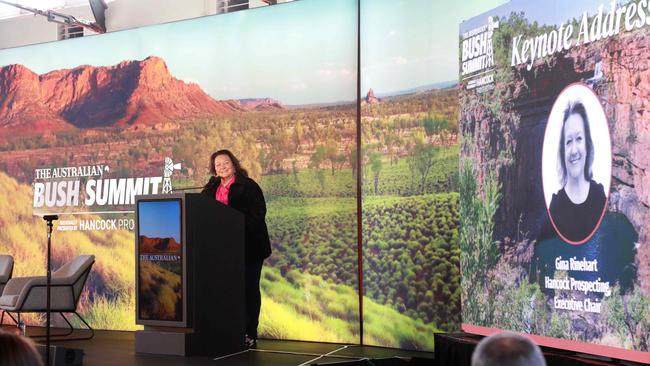Talk Gina Rinehart has bought into Liontown Resources suggests a bigger lithium game at play
If Gina Rinehart is buying Liontown Resources shares, there’s probably more at stake than a single takeover play.

The apparent intervention of Gina Rinehart’s Hancock Prospecting into the $6.6bn takeover of Liontown Resources suggests a broader play for a dominant position in Australia’s lithium sector is emerging.
Given her public support of coal and nuclear power, Rinehart is hardly the magnate you would most associate with the hunt for battery-making materials.
But mining is mining, and Hancock Prospecting’s Indian partners are pretty keen on the stuff.
Before Thursday Hancock was already sitting at about 4.9 per cent of Liontown stock and market sources suggest the day’s buying spree is aimed at building that stake to about 10 per cent.
If that is the case, it suggests Rinehart is looking to be dealt into a broader deal with Albemarle, rather than setting Hancock up for a rival takeover bid, even though Thursday’s raid comes before Albemarle and Liontown settle the terms of exclusive due diligence.
A 10 per cent position would look like a pretty effective blocking stake, given the likely shape of any friendly deal between Albemarle and Liontown would take the form of a scheme of arrangement – in which Liontown chairman Tim Goyder’s 15 per cent holding in the company would be the biggest bloc, and not every share would be voted.
And a scheme of arrangement does not preclude Hancock cutting a side deal with other parties to the takeover negotiations.
It’s also worth noting that Chris Ellison’s Mineral Resources has a longstanding relationship with Hancock, and a raft of joint venture deals in iron ore. MinRes, of course, also has a successful joint venture arrangement with Albemarle.

There’s no arguing with Hancock’s expertise when it comes to mining, but the company has no particular expertise in higher-level processing in battery minerals – which MinRes is trying to build, and Albemarle has in spades.
MinRes also has its own interest in assets associated with Albemarle’s Liontown takeover, as its bid for the Bald Hill mine indicates, and Ellison’s moves on other companies around the Gold Fields lithium sector suggest the potential of a far broader play to establish a dominant West Australian lithium powerhouse.
In that picture a loose alliance of Albemarle (which already owns half of the Greenbushes lithium mine), MinRes and others would become the biggest player in WA’s hard-rock sector – add Albemarle’s global processing expertise and the a very significant rival to China’s processing dominance could eventually emerge.
That would also very much be in the long-term interests of India, which has its own ambitions for a battery and electric vehicle industry.
Speaking at the Minerals Council’s conference in Canberra this week, Indian High Commissioner Manpreet Vohra was very keen to make it clear his country sees Australia as a key ally in India’s quest for security of supply in critical minerals. Mr Vohra said India would be more than happy to co-operate with Australian companies to build local value-adding facilities as part of an integrated supply chain feeding India’s manufacturing industry – in effect, replicating India’s status as an anchor buyer for Queensland coking coal.
All of that would also fit in with the federal government’s preference to eventually direct Australian critical minerals towards geopolitical allies rather than continuing to feed Australian raw materials into China’s dominant market position in the battery supply chain.
It would be a step too far to suggest geopolitical manoeuvring is playing any major role in the current roll-up of WA’s lithium sector, but the importance of securing supply chains should not be ignored, particularly given Treasurer Jim Chalmers has demonstrated his willingness to block China-linked buyers of critical minerals projects.
But the cosy position of iron ore’s biggest producers – Rio, BHP, Vale and Fortescue – sets a pretty good example for lithium also, and a race may well be forming to lock down as much of Australia’s future production as possible.



To join the conversation, please log in. Don't have an account? Register
Join the conversation, you are commenting as Logout